Baseball cap
A baseball cap is a type of soft cap with a rounded crown and a stiff bill[1] projecting in front.
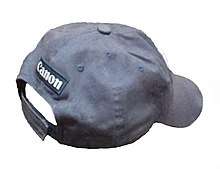
The front of the cap typically displays a design or a logo (historically, usually only a sports team, namely a baseball team, or names of relevant companies, when used as a commercial marketing technique). The cap may be "fitted" to the wearer's head or the back may have elastic, a plastic prong-in-a-hole (multiple holes with one prong that can be inserted), Velcro, a zipper, or a tri-glide slide so that it can be quickly adjusted to fit different wearers' heads. The baseball cap is a part of the traditional baseball uniform worn by players, with the brim pointing forward to shield the eyes from the sun. Since the 1980s, varieties of the hat have become prevalent in the United States and many other nations, both for utilitarian (protecting the eyes from the sun) and fashion accessory purposes.
History

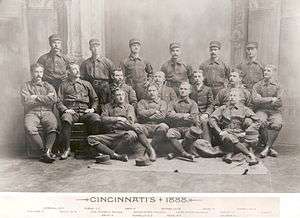
In 1860, the Brooklyn Excelsiors wore the ancestor of the modern rounded-top baseball cap, which featured a long peak and a button on top, and by 1900, the "Brooklyn style" cap became popular.[2] During the 1940s, latex rubber became the stiffening material inside the hat and the modern baseball cap was born. The peak, also known in certain areas as the "bill" or "brim", was designed to protect a player's eyes from the sun. Typically, the peak was much shorter in the earlier days of the baseball hat. Also, the hat has become more structured, versus the overall "floppy" cap of the 19th and early 20th centuries. The baseball cap was and still is an important means by which to identify a team. Often the logo, mascot, or team's initial was placed on the cap. Usually, the cap was also fashioned in the official colors of a particular team.
The basic shape, including curved peak, is similar to some styles of 19th century sun bonnets.[3]
Design
Fitted baseball caps — those without an adjuster — are normally sewn in six sections, and may be topped with a matching fabric-covered button (also called a squatchee) on the crown. Metal grommets or fabric eyelets are often sewn or attached near the top of each of the six sections of fabric to provide ventilation. In some cases, the rear sections of the crown are made of net-like mesh material for extra ventilation. The peak is typically stiffened by a sewn-in piece of paperboard or stiff plastic.
Variations
Baseball caps are made of many types of material and shaped in various styles for different purposes. Major and minor league baseball players wear classic-style caps made of wool (or, more recently, polyester) with their team's simple logo and colors; the logo is usually embroidered into the fabric. More recently there are brands that are using uncommon materials for snapback hats as for example wood brims.[4]
Formerly, baseball caps only came in standard hat sizes. Since the early 1970s, they have also been available in a one-size-fits-all form, with an adjustment strap in the back. The style, commonly called snapback, has become increasingly popular as fashion accessories.[5] Advances in textiles have led to the "stretch-fit" hat, which uses Lycra or rubber to allow a hat to have a fitted style while still being "adjustable" within sizes.
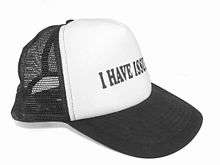
The front may be soft, or may be stiffened by buckram to display a logo more clearly.[6]
Another version of the baseball cap is a plastic mesh cap with a foam front imprinted with a company logo. This style is sometimes called a trucker cap or a "gimme cap" because it is given away for free as a promotional item.
Dad hats are unstructured caps with low profile, curved brim, and stripe on the back.
There are 4 major types of baseball caps:
- Snapback hat - (hat with a snap closure in the rear) with flat brim, high profile, adjustable.
- Adjustable hat - (hat with a velcro closure in the rear) unstructured, low profile, curved brim, adjustable.
- Fitted hat - curved or flat brim, structured cap, high profile, unadjustable.
- "Flexfit" hat - curved or flat brim, structured cap, high profile, adjustable by the use of elastic materials.
Athletic use
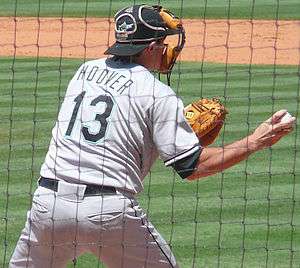
Beginning with the 2014 season, MLB pitchers are permitted to wear a special reinforced cap to protect their heads from line drives.[7]
Athletes in other sports wear caps with their team's logo and colors as "sideline" caps; both types are also sold as authentic team merchandise in retail stores. Other caps may simply have a maker's logo, such as Reebok, Nike or Carhartt; these hats are often made of brushed cotton. Golfers tend to prefer the sports visor form which does not cover the head but keeps the sun out of their eyes; women also traditionally have worn visors casually but a trend in certain youth subcultures sees an increase in feminine use of full caps.
Professional use
Military
%2C_Commanding_Officer%2C_Cmdr._William_Kearns_III%2C_communicates_with_his_combat_information_center.jpg)
Some armed forces use baseball caps as part of their uniforms, including the United States Navy and United States Coast Guard. Used mostly with the utility uniform and coveralls, the baseball cap usually has a command logo on the front to denote command affiliation. Baseball caps of a particular color are worn to denote a specific function of a person or particular job. For example, in the United States submarine force, red baseball caps are worn by drill monitors who facilitate and critique members of the boat's crew during drills. In the United States Army, parachute riggers wear red baseball caps and parachute instructors wear black baseball caps as part of their uniform. In various squadrons of the United States Air Force's civilian auxiliary, squadron-distinctive baseball caps have been issued as headgear (or "cover") for the Battle Dress Uniform, typically displaying squadron colors, squadron number, and/or squadron patch. Although the BDUs have their own cover, a patrol cap in M81 Woodland, some squadrons have opted for more distinctive covers.
Police
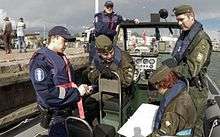
See also: Uniform#Police
In many United States police forces, the baseball cap is worn as a more practical alternative to the traditional peaked cap or campaign hat, the latter of which is generally used by Sheriff's departments and state police forces. This is more common on the West Coast, whereas in eastern states the traditional peaked cap is more prominent. A notable exception is the San Francisco Police Department, where peaked caps are still worn regularly. Turkish police switched from peaked caps to baseball caps in the 1990s. In Slovenia, policemen on motorcycles wear baseball caps as a part of their uniform, when they remove the helmet. The baseball cap is also commonly used by private security companies as a cheap, practical piece of uniform headgear.
There has been a marked trend in recent years among police forces and other uniformed bodies throughout the world to substitute cheap and comfortable baseball caps for peaked caps and other traditional headdresses. In Britain the baseball cap has the additional advantage of being unisex and suitable for wear by both male and female officers. During 2017 the Northamptonshire, Cheshire and Lancashire police forces adopted specially strengthened baseball caps known as "Bump Caps", to replace the helmets and bowler hats previously worn.[8]However the Northamptonshire force announced in November 2018 that their "Bump Caps" had proven scruffy and unpopular, and would be withdrawn from use.[9]
The Finnish Police uses a baseball cap (seen on the image at this link), which is considered an official identification device and cannot be worn or even displayed by civilians, and has mostly replaced the traditional side cap.[10][11] Many armed police units around the world, notably SWAT in the United States and Metropolitan Police's Specialist Firearms Command in the United Kingdom, often wear baseball caps to shield their eyes from the sun where a full helmet would be excessive.
See also
- Baseball clothing and equipment
- Beanie (seamed cap)
- Cricket cap, a similar cap in a similar sport
- Flat cap
- List of headgear
References
- "Definition of Bill by Merriam Webster". Merriam Webster. bill noun (1) definition 4. Retrieved 2019-12-02.
- "Baseball cap has endured generations as the all-American hat". Retrieved 2014-04-26.
- BBC – Happy 59th, baseball caps 18 December 2008
- Dabrowiecki, Jamie (2016-11-07). "Want a wooden brim strapback? We've got you covered". Archived from the original on 2018-02-05. Retrieved 2018-02-04.
- "Mens Fashion Trend: Snapback Caps". Archived from the original on 2014-04-27. Retrieved 2014-04-26.
- Taxdahl, Jeff (2012-12-20). "What's the difference between a constructed and an unconstructed cap?". Archived from the original on 2017-01-07. Retrieved 2017-01-06.
- "MLB approves protective cap for pitchers in time for 2014 season". Retrieved 2014-04-26.
- Harley, Nicola (10 May 2017). "Police swap helmets for caps to attract more transgender officers" – via www.telegraph.co.uk.
- Northamptonshire Chronicle & Echo 15 November 2018
- "Poliisilippistä on laitonta pitää esillä". Archived from the original on 2018-01-04. Retrieved 2018-01-03.
- "Lakki on poliisille tärkeä turvallisuusvaruste". Yle Uutiset.